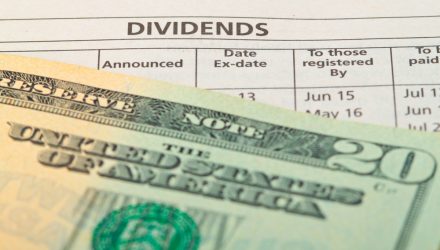After years of seemingly unfettered growth, S&P 500 dividends are likely to contract this year thanks to a spate of cuts and suspensions in the several months of 2020. However, investors can mitigate some of that risk with ETFs such as the ProShares S&P 500 Aristocrats ETF (CBOE: NOBL) and the ProShares Russell U.S. Dividend Growers ETF (TMDV).
NOBL tracks the S&P 500 Dividend Aristocrats Index, targets the cream of the crop, only selecting components that have increased their dividends for at least 25 consecutive years. Consequently, investors are left with a portfolio of high-quality, sustainable dividend payers.
The ProShares Russell U.S. Dividend Growers ETF is unique among dividend growth ETFs currently on the market. That new ETF tracks the Russell 3000 Dividend Elite Index, which requires member firms to have minimum dividend increase streaks of at least 35 years.
Broadly speaking, 2020 is proving unkind to dividend investors, but dividend growers have track records of weathering rough environments.
“Dividends, which have always been a major contributor to total S&P 500 returns, have actually been responsible for the majority of stock returns in difficult times (e.g., during the 1970s),” said ProShares in a recent note. “And this was despite the fact that difficult times are precisely when companies might be most compelled to cut or eliminate their dividends.”
These Days, Quality Matters
Investors should consider quality dividend growth stocks that typically exhibit stable earnings, solid fundamentals, strong histories of profit and growth, commitment to shareholders, and management team convection in their businesses.
“So it behooves investors—both those focused on dividend income and those focused on total return—to pay attention to how companies are managing their dividends during this pandemic,” according to ProShares.
On a historical basis, companies with steady records of dividend increase outperform those that don’t grow payouts and the growers are often less volatile,
“Sector-related patterns of dividend risk can vary dramatically in different environments,” notes ProShares. “Challenging economic conditions can be driven by financial crises, energy crises, geopolitical crises, and, as of late, health crises. Regardless of the environmental drivers, quality metrics—measures such as a company’s leverage, earnings quality and stability, dividend yields, and payout ratios—are another important lens for examining dividend risk.”
The consumer staples, industrial and utilities sectors combine for about 44% of TMDV’s roster. Dividend growth is a hallmark of quality, and these companies provide the best level of dividend growth, with a legacy of stability and strength, demonstrating a history of weathering market turbulence.
For more on core investing strategies, please visit our Core Equity Channel.
The opinions and forecasts expressed herein are solely those of Tom Lydon, and may not actually come to pass. Information on this site should not be used or construed as an offer to sell, a solicitation of an offer to buy, or a recommendation for any product.

